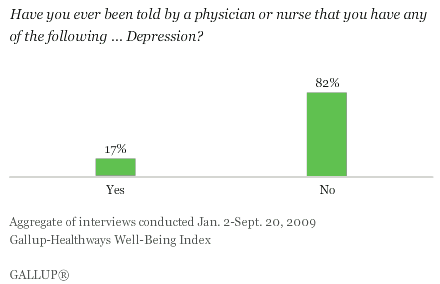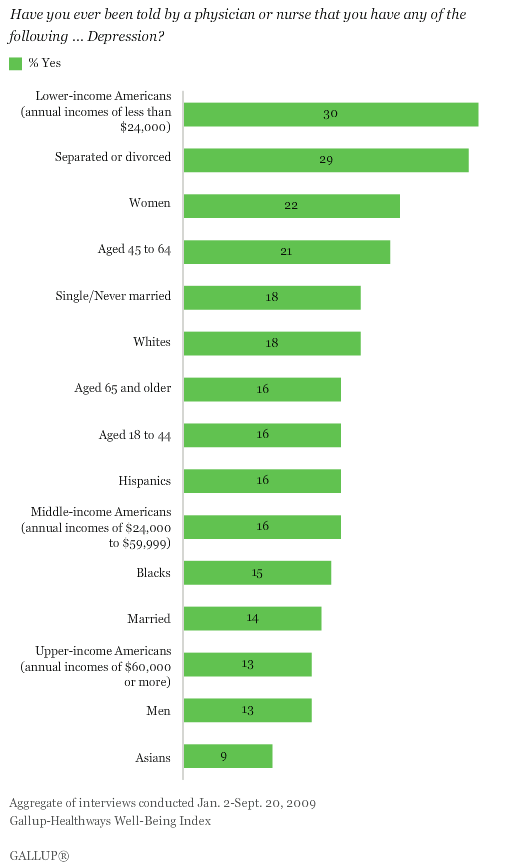WASHINGTON, D.C. -- The Gallup-Healthways Well-Being Index reveals that 17% of respondents -- or about 40 million American adults -- report having been diagnosed with depression. The results are from more than 250,000 interviews conducted in 2009 as part of the Gallup-Healthways Well-Being Index.

Americans making less than $24,000 a year and those who are separated or divorced are the most likely of all the subgroups analyzed here to report having been diagnosed with depression -- at 30% and 29%, respectively. Women and those aged 45-64 also report that they have been diagnosed with depression at a level higher than the national average, in the 21% to 22% range. Asians, men, those with annual incomes of at least $60,000, and those who are married are least likely of the subgroups analyzed here to report having been diagnosed with depression.

It is interesting to note that middle-income Americans are only slightly more likely than upper-income Americans to report having been diagnosed with depression. In addition, blacks, Hispanics, and Asians are all at least slightly less likely than whites to report having been diagnosed.
Cumulative Risks
Many of the variables that are related to reports of depression work in a cumulative fashion; when Americans fall into more than one of these higher-risk categories, their likelihood to report that they have been diagnosed with depression increases. For example, women are more likely than men to fall into the lowest income bracket (25% vs. 19%, respectively) and are more likely to be separated or divorced (16% vs.11%). Among separated or divorced women who report making less than $24,000 per year, 45% report having been diagnosed with depression -- which is more than twice the national average. At the other extreme, the percentage of Asian men making at least $60,000 per year who report having ever been depressed is only 4% -- less than a quarter of the national average.
Questions of Causality and Measurement
It is important to remember that some variables that appear to be risk factors for depression can also be consequences of a major depressive episode. For instance, chronic depression may cause an inability to work, which may lead to poverty. Variables that appear to be risk factors can also be consequences of variables that occur even further up in a causal chain. For instance, serious health problems may simultaneously lead to both depression and poverty. Finally, demographic groups may differ not only in their susceptibility to depression but in their ability or willingness to seek treatment (and thus, to be diagnosed). Some have argued that one reason for the gender difference in depression is that women are more likely than men to seek treatment. In short, measuring self-reports of diagnosis of depression cannot establish causes. Further, self-reports could be different from actual rates of clinical depression because there is variance in who decides to seek help.
Bottom Line
The Gallup-Healthways Well-Being Index findings, based on interviews with more than 250,000 Americans, complement smaller-scale clinical studies of who is at risk for depression. For example, they support the finding that women are more prone to depression than are men and that poverty is a risk factor for depression. The powerful results for marital status also support the idea that social stressors play a large role in depression. Together, these findings provide an empirical basis for further research and dialogue on what clinicians often call "the common cold of mental illness" due to the high prevalence of depression in American society.
Survey Methods
Results are based on telephone interviews with 258,141 national adults, aged 18 and older, conducted Jan. 2-Sept. 20, 2009. Sample sizes for the main demographic groups range from a high of 130,282 women to a low of 3,365 Asians. Maximum margins of error accordingly range from a low of less than ±0.5 percentage points for women to less than ±2 percentage points for Asians.
Interviews are conducted with respondents on land-line telephones and cellular phones.
In addition to sampling error, question wording and practical difficulties in conducting surveys can introduce error or bias into the findings of public opinion polls.
About the Gallup-Healthways Well-Being Index™
The Gallup-Healthways Well-Being Index is the first and largest survey of its kind, with 1,000 calls a day, seven days a week. It is the official statistic for Wellbeing in America, giving a daily measure of people's wellbeing at the close of every day based on the World Health Organization (WHO) definition of health as not only the absence of infirmity and disease but also a state of physical, mental and social wellbeing. The Well-Being Index will be a daily measure determining the correlation between the places people work and the communities in which they live, and how that and other factors impact their wellbeing. Additionally, the Well-Being Index will increase the understanding of how those factors impact the financial health of corporations and communities.
Learn more about the Gallup-Healthways Well-Being Index.
